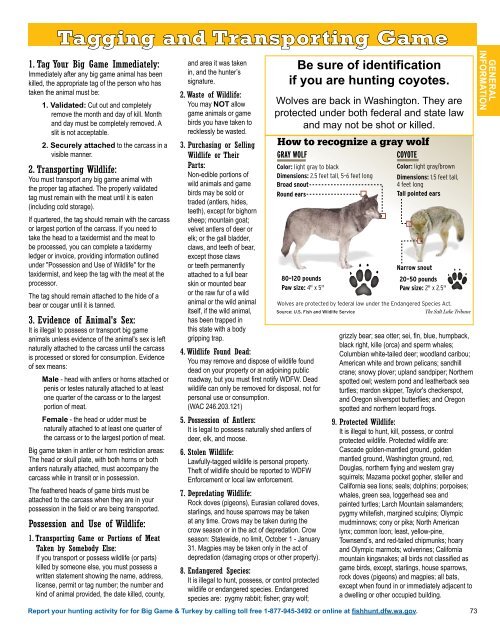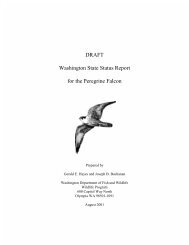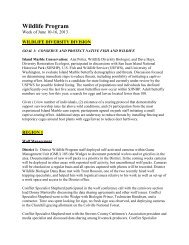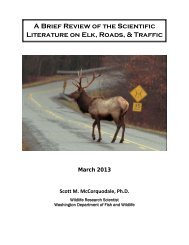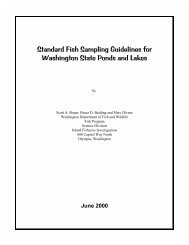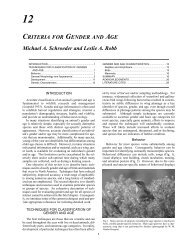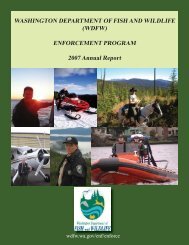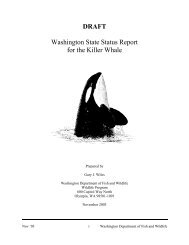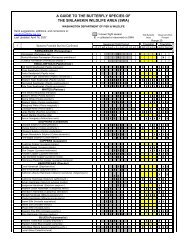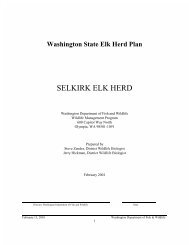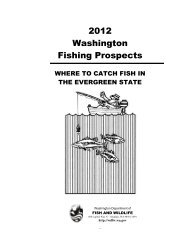Washington's 2010 Big Game Hunting Seasons & Regulations
Washington's 2010 Big Game Hunting Seasons & Regulations
Washington's 2010 Big Game Hunting Seasons & Regulations
Create successful ePaper yourself
Turn your PDF publications into a flip-book with our unique Google optimized e-Paper software.
Tagging and Transporting <strong>Game</strong><br />
1. Tag Your <strong>Big</strong> <strong>Game</strong> Immediately:<br />
Immediately after any big game animal has been<br />
killed, the appropriate tag of the person who has<br />
taken the animal must be:<br />
1. Validated: Cut out and completely<br />
remove the month and day of kill. Month<br />
and day must be completely removed. A<br />
slit is not acceptable.<br />
2. Securely attached to the carcass in a<br />
visible manner.<br />
2. Transporting Wildlife:<br />
You must transport any big game animal with<br />
the proper tag attached. The properly validated<br />
tag must remain with the meat until it is eaten<br />
(including cold storage).<br />
If quartered, the tag should remain with the carcass<br />
or largest portion of the carcass. If you need to<br />
take the head to a taxidermist and the meat to<br />
be processed, you can complete a taxidermy<br />
ledger or invoice, providing information outlined<br />
under "Possession and Use of Wildlife" for the<br />
taxidermist, and keep the tag with the meat at the<br />
processor.<br />
The tag should remain attached to the hide of a<br />
bear or cougar until it is tanned.<br />
3. Evidence of Animal's Sex:<br />
It is illegal to possess or transport big game<br />
animals unless evidence of the animal's sex is left<br />
naturally attached to the carcass until the carcass<br />
is processed or stored for consumption. Evidence<br />
of sex means:<br />
Male - head with antlers or horns attached or<br />
penis or testes naturally attached to at least<br />
one quarter of the carcass or to the largest<br />
portion of meat.<br />
female - the head or udder must be<br />
naturally attached to at least one quarter of<br />
the carcass or to the largest portion of meat.<br />
<strong>Big</strong> game taken in antler or horn restriction areas:<br />
The head or skull plate, with both horns or both<br />
antlers naturally attached, must accompany the<br />
carcass while in transit or in possession.<br />
The feathered heads of game birds must be<br />
attached to the carcass when they are in your<br />
possession in the field or are being transported.<br />
Possession and Use of Wildlife:<br />
1. Transporting <strong>Game</strong> or Portions of Meat<br />
Taken by Somebody Else:<br />
If you transport or possess wildlife (or parts)<br />
killed by someone else, you must possess a<br />
written statement showing the name, address,<br />
license, permit or tag number; the number and<br />
kind of animal provided, the date killed, county,<br />
and area it was taken<br />
in, and the hunter’s<br />
signature.<br />
2. Waste of Wildlife:<br />
You may NOT allow<br />
game animals or game<br />
birds you have taken to<br />
recklessly be wasted.<br />
3. Purchasing or Selling<br />
Wildlife or Their<br />
Parts:<br />
Non-edible portions of<br />
wild animals and game<br />
birds may be sold or<br />
traded (antlers, hides,<br />
teeth), except for bighorn<br />
sheep; mountain goat;<br />
velvet antlers of deer or<br />
elk; or the gall bladder,<br />
claws, and teeth of bear,<br />
except those claws<br />
or teeth permanently<br />
attached to a full bear<br />
skin or mounted bear<br />
or the raw fur of a wild<br />
animal or the wild animal<br />
itself, if the wild animal,<br />
has been trapped in<br />
this state with a body<br />
gripping trap.<br />
4. Wildlife Found Dead:<br />
You may remove and dispose of wildlife found<br />
dead on your property or an adjoining public<br />
roadway, but you must first notify WDFW. Dead<br />
wildlife can only be removed for disposal, not for<br />
personal use or consumption.<br />
(WAC 246.203.121)<br />
5. Possession of Antlers:<br />
It is legal to possess naturally shed antlers of<br />
deer, elk, and moose.<br />
6. Stolen Wildlife:<br />
Lawfully-tagged wildlife is personal property.<br />
Theft of wildlife should be reported to WDFW<br />
Enforcement or local law enforcement.<br />
7. Depredating Wildlife:<br />
Rock doves (pigeons), Eurasian collared doves,<br />
starlings, and house sparrows may be taken<br />
at any time. Crows may be taken during the<br />
crow season or in the act of depredation. Crow<br />
season: Statewide, no limit, October 1 - January<br />
31. Magpies may be taken only in the act of<br />
depredation (damaging crops or other property).<br />
8. Endangered Species:<br />
It is illegal to hunt, possess, or control protected<br />
wildlife or endangered species. Endangered<br />
species are: pygmy rabbit; fisher; gray wolf;<br />
Be sure of identification<br />
if you are hunting coyotes.<br />
Wolves are back in Washington. They are<br />
protected under both federal and state law<br />
and may not be shot or killed.<br />
<br />
GRAY WOLF COYOTE<br />
Color: light gray to black<br />
Dimensions: 2.5 feet tall, 5–6 feet long<br />
Broad snout<br />
Round ears<br />
80–120 pounds<br />
Paw size: 4" x 5"<br />
Color: light gray/brown<br />
Dimensions: 1.5 feet tall,<br />
4 feet long<br />
Tall pointed ears<br />
Narrow snout<br />
20–50 pounds<br />
Paw size: 2" x 2.5"<br />
Wolves are protected by federal law under the Endangered Species Act.<br />
Source: U.S. Fish and Wildlife Service The Salt Lake Tribune<br />
grizzly bear; sea otter; sei, fin, blue, humpback,<br />
black right, kille (orca) and sperm whales;<br />
Columbian white-tailed deer; woodland caribou;<br />
American white and brown pelicans; sandhill<br />
crane; snowy plover; upland sandpiper; Northern<br />
spotted owl; western pond and leatherback sea<br />
turtles; mardon skipper, Taylor's checkerspot,<br />
and Oregon silverspot butterflies; and Oregon<br />
spotted and northern leopard frogs.<br />
9. Protected Wildlife:<br />
It is illegal to hunt, kill, possess, or control<br />
protected wildlife. Protected wildlife are:<br />
Cascade golden-mantled ground, golden<br />
mantled ground, Washington ground, red,<br />
Douglas, northern flying and western gray<br />
squirrels; Mazama pocket gopher, steller and<br />
California sea lions; seals; dolphins; porpoises;<br />
whales, green sea, loggerhead sea and<br />
painted turtles; Larch Mountain salamanders;<br />
pygmy whitefish, margined sculpins; Olympic<br />
mudminnows; cony or pika; North American<br />
lynx; common loon; least, yellow-pine,<br />
Townsend’s, and red-tailed chipmunks; hoary<br />
and Olympic marmots; wolverines; California<br />
mountain kingsnakes; all birds not classified as<br />
game birds, except, starlings, house sparrows,<br />
rock doves (pigeons) and magpies; all bats,<br />
except when found in or immediately adjacent to<br />
a dwelling or other occupied building.<br />
Report your hunting activity for for <strong>Big</strong> <strong>Game</strong> & Turkey by calling toll free 1-877-945-3492 or online at fishhunt.dfw.wa.gov. 73<br />
GENERAL<br />
INfORMATION


